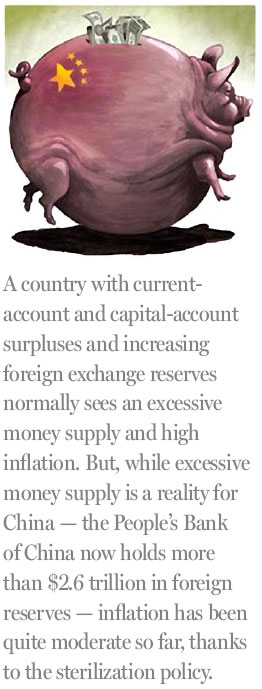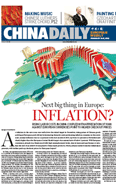Fan Gang
Monetary moves are to stem overheating
Updated: 2010-12-03 14:28
By Fan Gang (China Daily European Weekly)

Causes of global imbalance from the US also seem unlikely to disappear soon.
Not long after the United States Federal Reserve Board announced its second round of quantitative easing (known as QE2), the People's Bank of China (PBOC), China's central bank, announced two increases of 0.5 percentage points in the required reserve ratio (RRR) of bank deposits. The RRR now stands at 18.5 percent, a historic high, even in global terms.
While the Fed is planning to pump more money into the US economy, the PBOC is trying to reduce the amount of money in circulation in China. Money used by commercial banks to satisfy the RRR, which is held in accounts at the PBOC, can no longer be extended as loans. As a result, more money than ever is now frozen or inactive in China.
It is understandable that the Fed wants to boost demand as long as the US economy remains depressed. But why has the PBOC tightened monetary policy so much? The Chinese economy is not overheating. Growth is still high, at about 10 percent per year, but has started to moderate. And, while inflation is a concern - having risen to 4.4 percent year-on-year in October, from 3.6 percent in September - this cannot explain why the PBOC raised the RRR three times earlier this year, when inflation was lower.
Instead, the PBOC's policy is pre-emptive: Sterilize over-liquidity and get the money supply under control in order to prevent inflation or overheating. At the beginning of the year, the RRR increases could be regarded as part of efforts to correct the oversupply of money that arose from the anti-crisis stimulus package. But the most recent RRR increases serve mainly to sterilize the "passive money supply" caused by the increase in foreign exchange reserves.
Indeed, in September alone, China's foreign currency reserves increased by almost $100 billion (76.3 billion euros) compared to August. With the global economy recovering, China's trade surplus began to grow. Moreover, capital inflows increased significantly, owing to real investment opportunities in the high-growth economy and the expectation of yuan revaluation.
But rapid growth in foreign exchange reserves means an increase in the domestic money supply because the PBOC issues 6.64 yuan (down 3 percent since June) for every dollar it receives. That means that money supply increased by nearly 700 billion yuan in September. The two 50-basis-point RRR increases just locked up the same amount of liquidity.
A country with current-account and capital-account surpluses and increasing foreign exchange reserves normally sees an excessive money supply and high inflation. But, while excessive money supply is a reality for China - the PBOC now holds more than $2.6 trillion in foreign reserves - inflation has been quite moderate so far, thanks to the sterilization policy.
The RRR is only one example of a textbook sterilization instrument. Another is to sell off government bonds held by the central bank in order to take money out of circulation - again, just the opposite of what the Fed is now doing. Because China's government does not owe much debt to the public, the PBOC sold its holdings of government bonds in 2005. So it had to create something else to sell.
It created so-called central bank bills, which commercial banks are supposed to buy voluntarily. When they do, the money they pay is also locked up in the PBOC's accounts. To date, up to 5-6 percent of total liquidity has been returned to the central bank in this way.
Furthermore, the PBOC uses unconventional instruments from time to time, such as "credit ceilings" or "credit quotas" imposed on commercial banks. This may result in "extra reserves", which commercial banks cannot use to extend their credit lines. Credit quotas imposed early this year have left Chinese commercial banks with 2-3 percent of extra reserves.
Adding up the impact of the PBOC's sterilization efforts, roughly one-quarter of China's total monetary base is not liquid. Thus, although China's total money supply seems excessive, with the M2-to-GDP ratio now at about 190 percent, the real monetary base is actually much smaller than it appears. As a result, China's inflation, as well as asset prices, remain under control.
For how long will this sterilization continue, and how far will it go? At what point will higher RRR levels cause Chinese commercial banks to begin running losses?
There may be room for further sterilization. First, unlike in some other countries, Chinese commercial banks are paid reasonable interest rates on required reserves, except for the "extra reserves" that they hold. So they do not lose much, if anything, from the PBOC's sterilization policies.
Second, China's central bank still controls interest rates by enforcing a roughly 3-percentage-point spread between deposit rates and lending rates. As a result, Chinese commercial banks can operate longer with a higher RRR than their counterparts elsewhere.
One key issue facing China is how to reduce the current- and capital-account surpluses in order to reduce foreign exchange holdings. Yes, further revaluation of the exchange rate is needed, but this can play only a secondary role. The most important task for China is to reduce the saving rate, which equaled 52 percent of GDP in 2009. A number of fiscal, social security, and tax reforms should be a priority for this purpose.
But it seems that both revaluation and reform will take time. Meanwhile, the causes of global imbalance on the US side also seem unlikely to disappear any time soon. And now, with the Fed's QE2 on the table, conditions may worsen before they improve. The PBOC may have to continue its sterilization for some time in the foreseeable future.
Fan Gang is professor of economics at Peking University and the Chinese Academy of Social Sciences, director of China's National Economic Research Institute, secretary-general of the China Reform Foundation, and a former member of the Monetary Policy Committee of the People's Bank of China.
E-paper

Ear We Go
China and the world set to embrace the merciful, peaceful year of rabbit
Preview of the coming issue
Carrefour finds the going tough in China
Maid to Order
Specials

Mysteries written in blood
Historical records and Caucasian features of locals suggest link with Roman Empire.

Winning Charm
Coastal Yantai banks on little things that matter to grow

New rules to hit property market
The State Council launched a new round of measures to rein in property prices.
